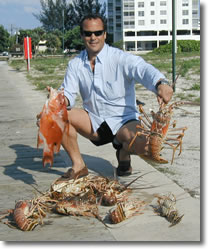Nope, they don't have claws--
you pinch them, they don't pinch you!
They sure do taste good! Anyone can learn to catch them in a dive or two! We KNOW the secret spots!
Give us a call, or email us, and I'll tell you exactly which loop to get (the metal or gereen one, not the monofilament one!) and where to buy your fishing license (you MUST have one). We can provide you with a Guide, who can teach you too! If you have never seen one of these, here's the complete background on the critters, courtesy of the Florida Marine Research Institute.
 Commonly referred to as the Florida spiny lobster, the Caribbean spiny lobster inhabits tropical and subtropical waters of the Atlantic Ocean, Caribbean Sea and Gulf of Mexico. Spiny lobsters get their name from the forward-pointing spines that cover their bodies to help protect them from predators. They vary in color from almost white to dark red-orange. Two large, cream-colored spots on the top of the second segment of the tail make spiny lobsters easy to identify. They have long antennae over their eyes that they wave to scare off predators and smaller antennae-like structures called antennules that sense movement and detect chemicals in the water.
Commonly referred to as the Florida spiny lobster, the Caribbean spiny lobster inhabits tropical and subtropical waters of the Atlantic Ocean, Caribbean Sea and Gulf of Mexico. Spiny lobsters get their name from the forward-pointing spines that cover their bodies to help protect them from predators. They vary in color from almost white to dark red-orange. Two large, cream-colored spots on the top of the second segment of the tail make spiny lobsters easy to identify. They have long antennae over their eyes that they wave to scare off predators and smaller antennae-like structures called antennules that sense movement and detect chemicals in the water.
Adult spiny lobsters make their homes in the protected crevices and caverns of coral reefs, sponge flats and other hard-bottomed areas. The lobsters spawn from March through August and female lobsters carry the bright orange eggs on their undersides until they turn brown and hatch. Larvae can be carried for thousands of miles by currents until they settle in shallow nearshore areas among sea grass and algae beds. They feed on small snails and crabs. The lobsters are solitary until they reach the juvenile stage, when they begin to congregate around protective habitat in nearshore areas. As they begin to mature, spiny lobsters migrate from the nursery areas to offshore reefs.
Lobsters stay in their dens during daylight hours to avoid predators, emerging a couple of hours after dark to forage for food. While lobsters will eat almost anything, their favorite diet consists mostly of snails, clams, crabs and urchins. The lobsters return to the safety of their dens several hours before sunrise. Unless you happen to grab the little bastards first.![]()
